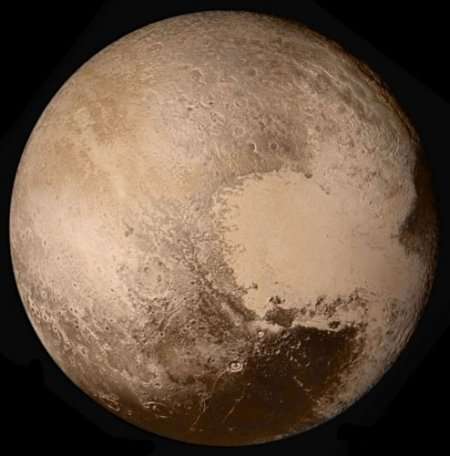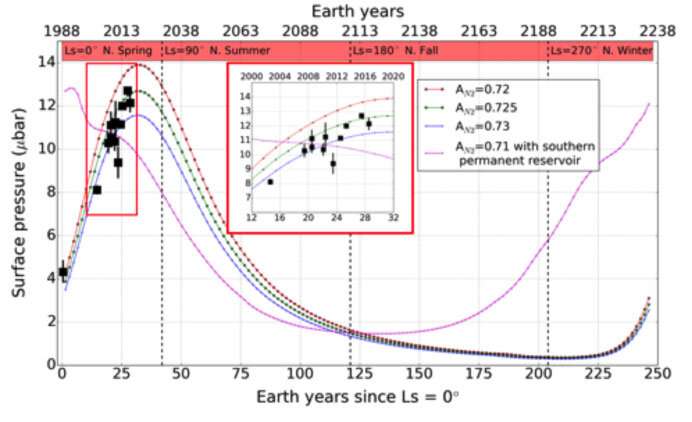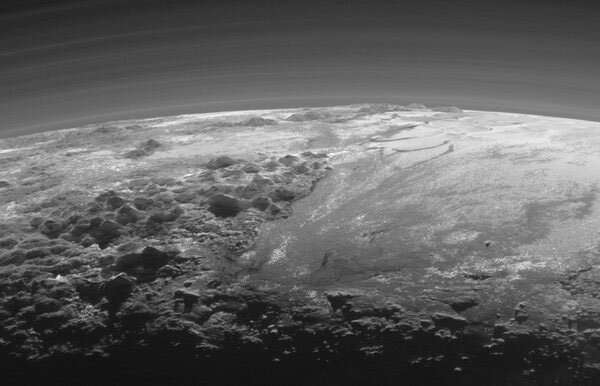Spring on Pluto: An analysis over 30 years

Whenever it passes in front of a star, Pluto provides precious information about its atmosphere, precious because occultations by Pluto are rare. The survey achieved by researchers from Paris Observatory over several decades of observations appears in the journal Astronomy and Astrophysics of May 10, 2019. Interpreted in the light of data collected in 2015 by the probe New Horizons, it allows them to refine physical parameters that are essential for a better understanding of Pluto's climate and to predicting future stellar occultations by the dwarf planet.
Like Earth, Pluto's atmosphere is essentially composed of nitrogen but the comparison stops there.
Beyond Neptune, Pluto takes 248 years to make a complete revolution around the sun. During a Plutonian year, its distance to the sun varies greatly from 30 to 50 au, leading to extreme seasonal cycles.
With extremely low surface temperatures, less than -230 ° C (40 ° K), there is a solid-gas equilibrium, where a tenuous atmosphere of essentially nitrogen coexists with surface ice deposits. Today, the nitrogen vapour is estimated to be stabilised at a pressure around 1.3 pascal (whereas the pressure is about 100 000 Pa on our planet).
Because of its obliquity (the angle formed between the polar axis and the orbital plane) at 120 degrees, Pluto's poles successively face a permanent day for several decades, then a permanent night. This leads to a complex cycle of redistribution of its volatile species such as nitrogen, methane and carbon monoxide. Thus Pluto had its equinox in 1988, before moving to perihelion (at 30 au) in 1989. Since then, the dwarf planet has continually moved away from the sun to reach 32 ua in 2016, which represents a loss of 25 percent of his average insolation.

Naively, a sharp fall in atmospheric pressure could be expected. In fact, the gas-ice balance of nitrogen imposes that for each degree Kelvin lost at the surface, the pressure should decrease by a factor of two.
But the exact opposite occurs. The proof is provided by the article that appeared in A&A of May 10, 2019, and which analyses a dozen of stellar occultations observed in nearly 30 years, during the spring in the northern hemisphere of Pluto: the atmospheric pressure increases by a factor of three between 1988 and 2016.
This paradoxical scenario was already considered by Pluto's global climate models (GCM) since the 1990s, but without certainty, as one scenario among many others. Several important parameters of the model remained to be constrained by observations.
These observations of stellar occultations from Earth, coupled with data collected during NASA New Horizons' Pluto flyby in July 2015, now allow a much more accurate scenario to be written.
New Horizons mapped the distribution and topography of ice on the surface of the dwarf planet, revealing a vast depression of more than 1000 km in diameter and 4 km deep, located near the equator between latitudes 25 ° S and 50 ° N, and called Sputnik Planitia. This depression locks up a part of the nitrogen available in the atmosphere, forming a gigantic glacier which is the true "heart" of the climate of the dwarf planet, since it regulates the atmospheric circulation via the sublimation of the nitrogen.

In addition, stellar occultations allow to constrain the subsoil's thermal inertia of the model, explaining the thirty-year phase shift between the transition to perihelion (1989) and the growth in pressure still observed today (Fig. 1). The subsoil has stored the heat and is restoring it gradually. Occultations also constrain the fraction of solar energy returned to space (bond albedo) of nitrogen ice and its emissivity.
Finally, these observations eliminate the possibility for the presence of a reservoir of nitrogen in the southern hemisphere (currently in a permanent night), which would produce a maximum of pressure much earlier than what is observed (magenta curve of Fig. 1).
This study is a nice illustration of complementarity between ground-based and space observations. Without the New Horizons flyby, ice distribution and topography would remain unknown, and without long-term monitoring of the atmosphere, Pluto's climate models could not be constrained.
Prediction of future occultations
Finally, the occultations also provide 19 Pluto's positions between 1988 and 2016, with an unequaled precision of a few milliarcsec (mas) in the sky. Such a precision, possible thanks to the Data Release 2 of the European Gaia mission, allows the authors to compute an ephemeris of Pluto with this equivalent precision for the next decade .
Thus, it will be possible to observe other occultations by Pluto and to monitor its climate... The theoretical models indicate that Pluto's atmosphere is currently near its maximum expansion. Future observations could confirm or refute this prediction. Are we going to see soon the beginning of this slow decline, which should reduce by a factor of twenty the atmospheric pressure of Pluto at the end, and cover its surface with a thin layer of glossy "white frost?"
More information: E. Meza et al. Lower atmosphere and pressure evolution on Pluto from ground-based stellar occultations, 1988–2016, Astronomy & Astrophysics (2019). DOI: 10.1051/0004-6361/201834281
Pluto's ephemeris from ground-based stellar occultations (1988-2016). arxiv.org/abs/1903.04800
Journal information: Astronomy & Astrophysics
Provided by Paris Observatory





















